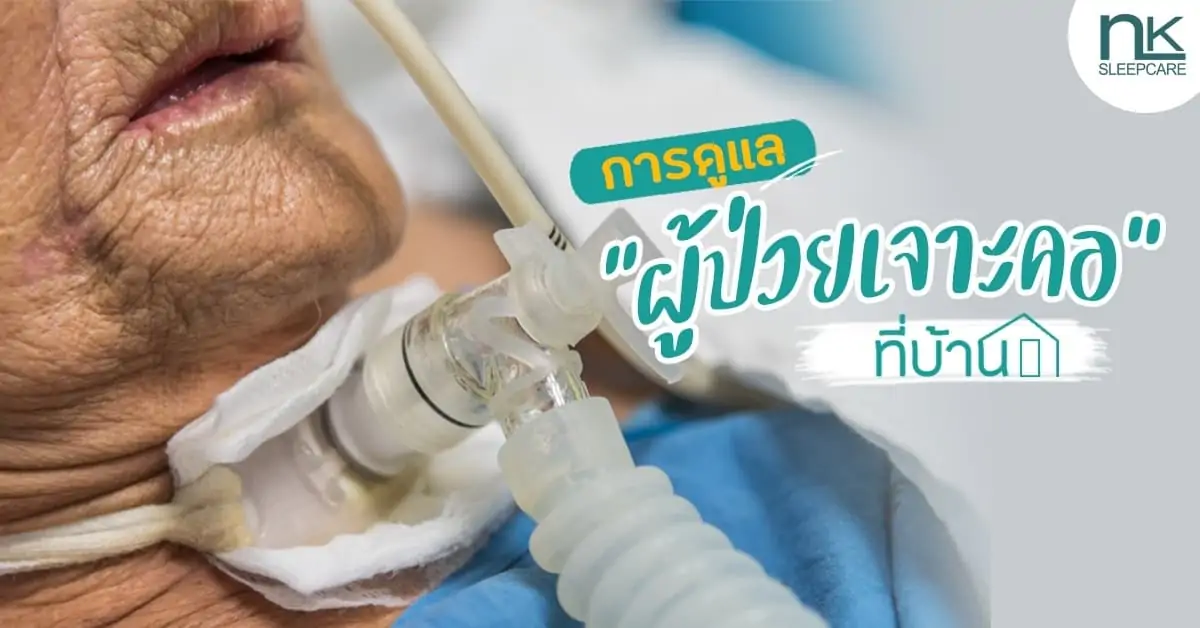Caring for a throat piercing patient (Tracheostomy) at home

Caring for pharyngeal patients at home It is a care that requires understanding and care that requires special attention. In the previous article, we have discussed the techniques for selecting masks for ventilators in the initial stages.
In this article, we will detail how to take care of a tracheal patient at home, including choosing a ventilator that is suitable for a tracheal patient.
What is a Throat Piercing (Tracheostomy)?
Throat puncture (Tracheostomy) is the opening of the upper respiratory tract in patients with obstructed upper airway conditions until unable to use nose or mouth to breathe Instead, doctors have to relocate breathing by creating a path between the trachea and the skin at the front of the neck, just below the larynx.
For the relief of obstruction in the upper respiratory tract or in sputum care and prevention of aspiration in patients on mechanical ventilation for a long time or in patients who are unable to cough up large amounts of sputum on their own.
What types of patients should have a neck piercing?
A throat aspiration is performed in patients who have a condition that blocks the airway so that they are unable to breathe on their own. whether it is acute or chronic including unconscious patients Paralyzed patients and bedridden patients who need to be intubated for a long time until causing a breakdown in the larynx area
Caring for pharyngeal patients at home
During the first week after throat piercing Your doctor will monitor your symptoms closely. Check to see if there are any abnormal symptoms. Because this is the period where the pipe is most prone to dislodging easily. It is also a period that must pay great attention to cleanliness. After 7 days or 1 week, the patient can go back for treatment at home.
Throat piercings are generally performed for patients who need a ventilator to survive at home. Because neck piercings can be treated more easily. And reduce the risk of slippage more than that.
How to take care of a throat piercing patient at home
- Wash your hands before and after caring for a patient.
- Use rubbing alcohol to clean joints.
- Position the patient to breathe easily and turn the patient every 2 hours.
- Keep the tracheal tube in place.
- Listen to the sound of the ventilator working.
- Be sure to observe the symptoms. potential
If you find any of the following abnormal symptoms, you should see a doctor immediately, whether
- Broken tracheal tube can be observed from Patients who can pronounce, during exhalation do not see mist coming up through the tracheal tubes, patients are restless, etc.
- The inner tube is missing or the tube cannot be inserted.
- Difficulty breathing
- having shortness of breath
- signs of infection, pain, swelling, redness, or pus around the throat piercing
- Bleeding from the bronchial tubes
What type of ventilator can be used for a tracheal patient?
because it's notVentilatorAll models that can be used in pharyngeal patients. Therefore, you should get advice from a doctor. or ask the dealer For the Philips ventilator that can be used with tracheal patients. The ventilator for tracheal puncture patients that can be used is Philips ventilator model BiPAP A40 onwards (Click to read details)




The balloon is attached from the drilled hole. There is usually a lot of wind. If water enters the balloon almost full What should I do?
The patient uses bi pap.
Consult with the doctor who takes care of the patient at all. It's best.
Patients with pharyngitis tend to have their inner tubes removed for a long time because they say they breathe more easily, are more comfortable, and cough less. Can I do this and fry the inner tube for a long time like this? And what are the consequences? Please help, the patient is very stubborn.
The tracheal tube should not be taken in and out often because it may be at risk of infection. Try to explain to the patient. And even if the doctor uses a ventilator as well, it should not be removed often. But should change the set of pipes to a new one or take it to sterilize according to the period recommended by the doctor.
That is, the throat piercing patient eats normal food, cleans the pipes in the morning and evening. but breath smells What is it from?
It may be caused by the smell of sputum that remains in the respiratory tract. Try using a phlegm suction machine for the patient and see if the smell disappears or not.
Is it normal for a bed-ridden patient to cough with sputum and saliva?
If you want to make the patient as comfortable as possible, they shouldn't have it. Advise the patient to suck sputum more often. And if using a ventilator or giving oxygen as well, a humidifier bottle should also be used. to reduce phlegm or to soften phlegm
Someone who has had a neck piercing and has a deep dent in the neck, can it be fixed to come back? His voice was hoarse as well.
It is advisable to consult with the doctor in charge of the patient. Usually, most leave it that way. But if there are other problems with the doctor may refer it to the surgeon to look at it for me
ผู้ป่วยเจาะคอเมื่อหายดีแล้ว(ประมาณ 2 ปี) ควรเย็บปิดหรือปล่อยให้ปิดเอง
ขึ้นอยู่กับแพทย์ที่ดูแลเป็นผู้พิจารณาครับ
คนไข้เจาะคอ ต้องให้ออกซิเจนไปตลอดมั้ยค่ะ
การให้ออกซิเจนกับผู้ป่วยเจาะคอขึ้นอยู่กับดุลยพินิจของแพทย์ที่รักษาครับ ว่าจำเป็นต้องให้หรือไม่ ถ้าให้ต้องใช้ปริมาณเท่าไหร่ และใช้นานเท่าไหร่ครับ
พ่อเจาะได้ประมาณ14-15วันไอตลอดเวลายิ่งกลางคืนไอทั้งคืนเสมหะเยอะมาก ทั้งที่ดูดเสมหะแล้วแบบนี้ปกติไหมคะ ผู้ป่วยทานข้าวเดินเล่นได้ปกติค่ะ
ถ้าผู้ป่วยเจาะคอมีเสมหะเยอะทำให้ไอตลอดเวลา อาจเป็นเพราะเสมหะมีความข้นเหนียวทำให้ระคายเคือง แนะนำให้เพิ่มความชื้นในอากาศเพื่อลดความเหนียวของเสมหะ ถ้าใช้เครื่องช่วยหายใจหรือให้ออกซิเจนแนะนำให้มีตัวทำความชื้นหรือให้อากาศผ่านกระบอกน้ำ หรือถ้าไม่ได้ใช้เครื่องดังกล่าวก็แนะนำให้ใช้เครื่องทำความชื้นในอากาศ หรือลองนอนในห้องที่ไม่ใช้เครื่องปรับอากาศดู แต่ทั้งนี้ก่อนเพิ่มความชื้นดังที่กล่าวมาควรปรึกษาแพทย์ก่อนทุกครั้งนะครับ